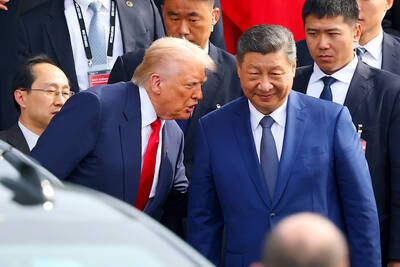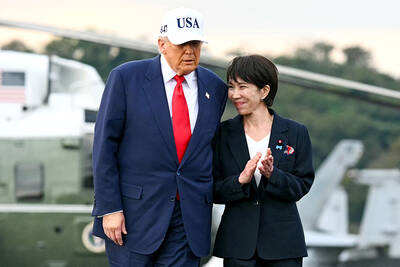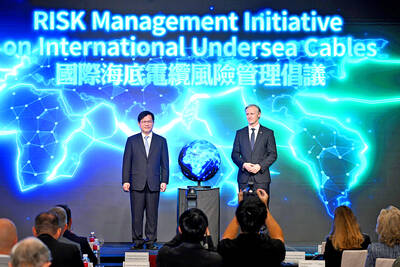China stands no chance of winning in an attempted invasion of Taiwan, National Security Bureau Director-General Chen Ming-tong (陳明通) said yesterday.
Chen made the remarks during a question-and-answer session at the legislature in Taipei after Chinese Nationalist Party (KMT) Legislator Lee Guei-min (李貴敏) asked him about US Chief of Naval Operations Michael Gilday’s comment on Wednesday that China could attack Taiwan as soon as this year or next year.
“A military invasion of Taiwan will lead to international sanctions and diplomatic isolation, [and Chinese President Xi Jinping, 習近平] would be to blame for sinking any hopes of a great ‘Chinese revival,’” Chen told a news conference.

Photo: CNA
Both sides of the Taiwan Strait should respect each other and develop their own countries, he added.
Many scenarios have been put forward regarding China’s “readiness” to invade Taiwan, Chen told lawmakers.
The more recent theories suggesting an invasion date of as early as next year to 2025 might be based on China’s attempts to force Taiwan to the negotiation table by threatening war, he said, without specifying what the negotiations could involve.
This could be carried out through a show of military force, for example by blockading Taiwan, which would be tantamount to war, Chen said.
The nation’s security apparatus has drafted plans to respond to such a scenario, he added.
Due to the ever-changing nature of warfare, it is difficult to predict exactly when a Chinese invasion could take place, Chen said.
The bureau takes note of all suggested timelines and is always on the lookout for any signs of a possible invasion, he added.
KMT Legislator Johnny Chiang (江啟臣) cited Ministry of Economic Affairs data showing that in the event of a blockade, Taiwan would only have 146 days of oil, 10 days of liquefied natural gas and 39 days of coal in its reserves.
“If we do not have power, it would not matter if we have Taiwan Semiconductor Manufacturing Co (台積電),” Chiang said.
Chen said he was not at liberty to respond to Chiang’s remarks.
Asked by reporters about Xi’s remarks during the Chinese Communist Party National Congress on Sunday that Beijing would not give up on the use of force to occupy Taiwan, Chen said Xi’s words were “cliche.”

UKRAINE, NVIDIA: The US leader said the subject of Russia’s war had come up ‘very strongly,’ while Jenson Huang was hoping that the conversation was good Chinese President Xi Jinping (習近平) and US President Donald Trump had differing takes following their meeting in Busan, South Korea, yesterday. Xi said that the two sides should complete follow-up work as soon as possible to deliver tangible results that would provide “peace of mind” to China, the US and the rest of the world, while Trump hailed the “great success” of the talks. The two discussed trade, including a deal to reduce tariffs slapped on China for its role in the fentanyl trade, as well as cooperation in ending the war in Ukraine, among other issues, but they did not mention

Japanese Prime Minister Sanae Takaichi yesterday lavished US President Donald Trump with praise and vows of a “golden age” of ties on his visit to Tokyo, before inking a deal with Washington aimed at securing critical minerals. Takaichi — Japan’s first female prime minister — pulled out all the stops for Trump in her opening test on the international stage and even announced that she would nominate him for a Nobel Peace Prize, the White House said. Trump has become increasingly focused on the Nobel since his return to power in January and claims to have ended several conflicts around the world,

GLOBAL PROJECT: Underseas cables ‘are the nervous system of democratic connectivity,’ which is under stress, Member of the European Parliament Rihards Kols said The government yesterday launched an initiative to promote global cooperation on improved security of undersea cables, following reported disruptions of such cables near Taiwan and around the world. The Management Initiative on International Undersea Cables aims to “bring together stakeholders, align standards, promote best practices and turn shared concerns into beneficial cooperation,” Minister of Foreign Affairs Lin Chia-lung (林佳龍) said at a seminar in Taipei. The project would be known as “RISK,” an acronym for risk mitigation, information sharing, systemic reform and knowledge building, he said at the seminar, titled “Taiwan-Europe Subsea Cable Security Cooperation Forum.” Taiwan sits at a vital junction on

LONG-HELD POSITION: Washington has repeatedly and clearly reiterated its support for Taiwan and its long-term policy, the Ministry of Foreign Affairs said US Secretary of State Marco Rubio yesterday said that Taiwan should not be concerned about being used as a bargaining chip in the ongoing US-China trade talks. “I don’t think you’re going to see some trade deal where, if what people are worried about is, we’re going to get some trade deal or we’re going to get favorable treatment on trade in exchange for walking away from Taiwan,” Rubio told reporters aboard his airplane traveling between Israel and Qatar en route to Asia. “No one is contemplating that,” Reuters quoted Rubio as saying. A US Treasury spokesman yesterday told reporters